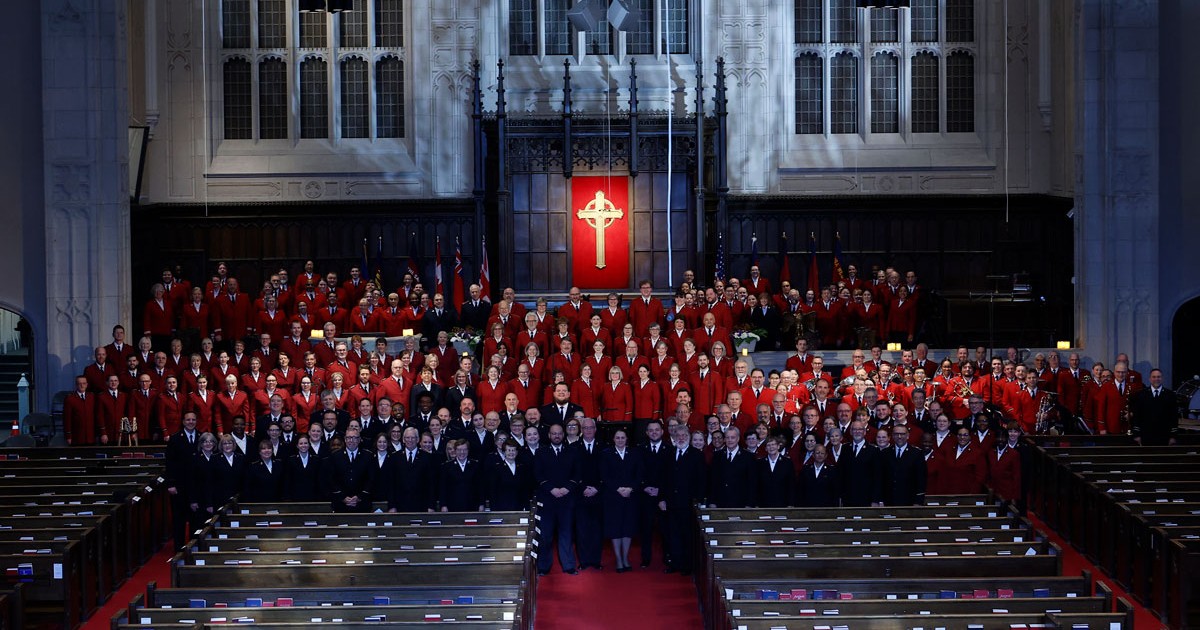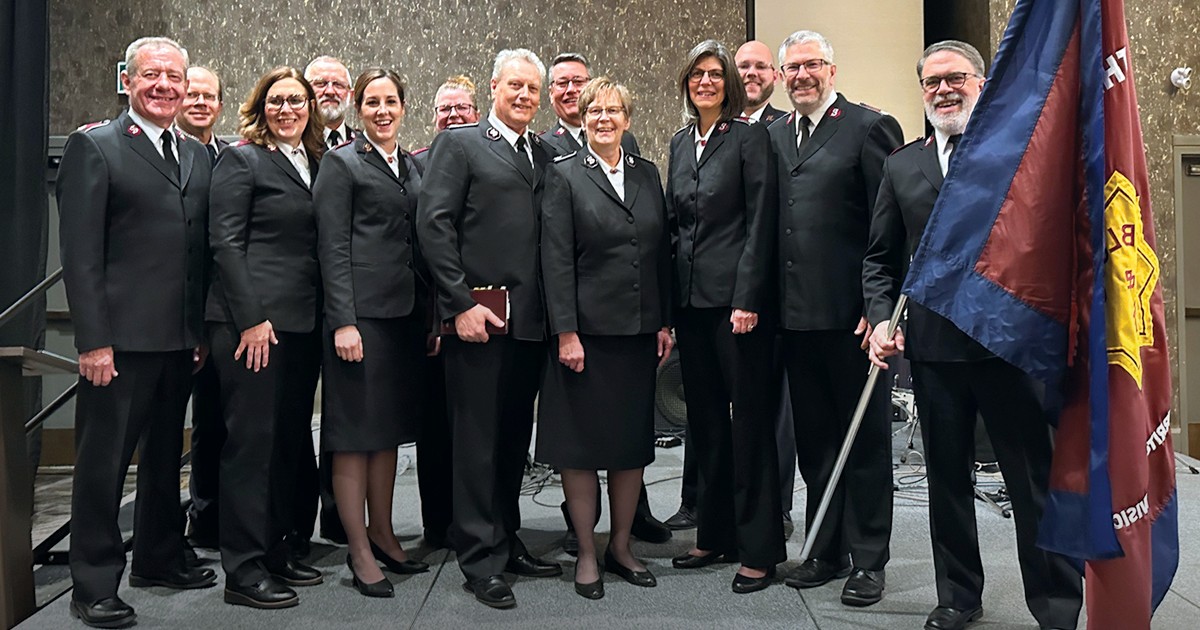
YES. The use of visual media helps the Church bring people closer to the story of Jesus.
BY CAPTAIN MARK DALLEY
“A picture is worth a thousand words”—Anon.
I love bookstores, so I decided to work at one when I was a university student. While there, I learned how easily we are swayed by appearance. For example, when you are in a bookstore, how do you decide which book to pick up? Most of us want to believe that we base our decision on the value of the content, but if the cover isn't attractive, we won't even bother looking at it.
We are surrounded by images in our society. Everywhere we look we see graphics, posters and videos.
The use of images has always been part of the life and worship in the Church. This is exactly how God intended it, which is why Scripture speaks so frequently of the use of image.
In Genesis 1 we are told that we were created in the image of God. This means that each one of us is a billboard for God—we are literally God's walking, breathing media. And in John 1, we are told that God's plan of redemption and revelation hinged on his revealing himself to us in the image of Christ, in the “medium” of a man. In fact, the Word needed to be transformed into the image of flesh so that God's glory could be fully revealed and salvation given through the “medium” of Christ's broken body.
Media itself is simply defined as the primary means of mass communication. Therefore, the cutting-edge medium of Jesus' day was parables. Jesus almost exclusively spoke in parables, using the images of the culture around him. He used parables because it allowed him to not only teach the deep truths of God but also to present them in an understandable way. Christ used the images of his culture and the media of his day to bring people into worship and relationship with God.
The use of media in the Church has always been of some debate. In the past this has been in the form of anything from stained-glass windows and popular music to the use of radio and TV. The real debate here is not about the use of media, but rather what forms of media are helpful to worship and which images should be used.
Many of you will remember the flannelgraph. I spent many years teaching Sunday school, and nothing helped me make the stories of Scripture more understandable than the flannelgraph. It was like a switch came on as my students were able to see, perhaps for the first time, the stories of the Bible play out before their eyes. The flannelgraph was the medium of the day and proved essential to the spiritual growth of many of us.
In Uncommon Lectionary, Tom Bandy writes, “Worship is a form of mission. It employs the indigenous cultural forms of any given micro-culture, in order to introduce seekers to Christ. Or, it employs whatever learning methodologies are most effective in any given micro-culture, in order to motivate disciples to witness, serve and model authentic Christian faith.... Worship is not intended by God or planning teams to send people to coffee, refreshments and conversation with their friends. It is intended to help people drink deeply from the fountain of grace, and send them to bring living water to the rest of the world.”
In other words, our use of images and the media that proclaim the gospel are integral to the mission that Christ laid out for us so many years ago. From the flag to the projector, the images of our worship have become the scrapbook of our lives together with each other and Christ.
As a corps officer, I have found that the type and amount of media used is directly dependent on the culture both within the congregation and the community in which we minister. What this means is that the media we employ must represent those we seek to reach rather than our own personal preferences. If the media that we use in our worship does not connect to the indigenous culture we seek to serve and to save, then we are hindering the mission of God.
No one picks up a book without a good cover, and no one keeps a book without a good story. Media, when used well, helps the Church bring people closer to the story of Jesus. We have the greatest story ever told, and the most powerful created image ever given: the cross. Knowing that the tool of media is available to me just as it was to Christ so many years ago, I would not want to attempt to portray the story of Jesus without it.
Captain Mark Dalley and his wife, Naomi, are the corps officers in Listowell, Ont.
NO. We should be wary of how dependent we've become on technology to guide our experiences in church.
BY JOHN McALISTER
As the congregation sings Did You Feel the Mountains Tremble?, I follow the words projected onto a large screen at the front of the church. Behind the words of the first verse, I'm shown a mountain in the background with clouds moving across the screen. On the second verse, I see images of people raising their hands in worship. For the third verse, I view a flowing river with birds flying in the sky. By the fourth verse, my eyes are sore and I'm mentally adjusting the first line to read, “Open up the doors and let me go home.”
All of this feels more like a full-out assault on the senses rather than a source of spiritual refreshment. Has the Church become too reliant on technology in its worship services? Whether it's the use of creative—and sometimes tacky—PowerPoint backgrounds or the prevalence of video clips accompanying devotional messages, we are obsessed with finding new ways to visually engage our congregants.
Since images already pervade our society through billboards, TV, Internet, movies, magazines and social media, people have come to expect a visual experience in everything they do. So, in order to connect with people in a relevant manner, the Church feels obliged to incorporate media into its worship services.
While I'm no Neo-Luddite—just try taking away my iPhone—I believe that we should be wary of how dependent we are on modern media in church. A good starting point is the question: What would our worship look like if we had no electricity this Sunday?
Although I earn a living by designing and managing websites, a part of me craves a community where the many distractions of the world are stripped away. In other words, a church unplugged. As God tells us in Psalm 46:10, “Be still, and know that I am God.” As a society oversaturated with visual stimuli, it takes great discipline for us to sit still. While we may think we're helping people to focus on the service through visual media, perhaps we're making it even harder for them to connect with God.
While I recognize that it's not feasible to eliminate technology altogether, we also shouldn't overdo it. For example, the words we sing each Sunday have their own power to inspire and challenge us; they don't need elaborate visual backgrounds to help us connect the dots. So, project the words on the screen, but use a simple background that doesn't distract.
We should also be aware of how PowerPoint presentations and other visual media are used in the secular world. In almost every case, they are created to sell things or to market an idea. While we may think we have redeemed this technology, people are pre-conditioned to respond warily to advertisements. As well, if our sermons incorporate many bulleted statements, we may be connecting with people on an intellectual basis but missing their hearts, which is where profound change occurs. Rather than unpack the reasons why we should believe or behave in a certain manner, our preachers should turn off the screen and tell an inspiring story of how God and his Word have impacted their lives or someone they know. The passion they exude will come across as real and uncontrived.
In The Importance of Being Foolish, Brennan Manning writes: “Consider how our churches have explored and exploited our need to replace the numbness in our lives with a passion for something, anything. We've created worship in which music is meant to stir the emotions but the soul is left unmoved, in which the words spoken are little more than manipulations of the heart. We have created cathartic experiences filled with weeping and dancing in the Spirit that leaves us with the sense that we have touched God but that fail to give us the sense that God has touched us. We run to churches where the message feels good and where we feel energized and uplifted—but never challenged or convicted.”
Of course we want our churches to be engaging and relevant. But we must ensure that they remain places where people can find divine intimacy, not just locations where we try to market and sell Christianity.
John McAlister is the features editor and web producer for The Salvation Army.









I do however see the benefit of having the songs on Power Point because there are times in my little corps when visitors come and we don't have enough songbooks or chorus books. For me I prefer a black background (or if there is a picture for it to be kept quite simple).
The other benefit to technology is when I am making a sermon illustration it is sometimes more helpful to show a video clip than to describe what I am thinking, because the reality is attention spans are much shorter than they once were and there may be a scene in a video that says the point I am getting across more effectively.
I am torn on this issue though, my corps currently has no projector/screen...we're looking into getting one but I think they key will be remembering to balance it's use in worship. It can be effective even in drawing people into a connection with the divine, but I also don't want my folks arriving at church with the same cynicism I used to wondering what movie we'll be watching today, and why are they not serving popcorn"